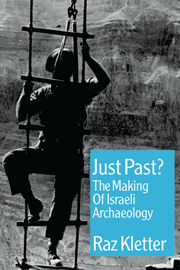Book contents
- Frontmatter
- Dedication
- Contents
- List of illustrations
- Introduction
- Acknowledgements
- Abbreviations
- 1 Archaeology and the 1948 War
- 2 Abandoned places, new places
- 3 Foreign aid
- 4 Frozen funds
- 5 A battalion of guards
- 6 Relief work
- 7 Man robs his land: “agreement” with General Dayan
- 8 “Gold of Ophir for Beth-Horon”: 3,000 shekels
- 9 The building beyond the border: the PAM, 1948–67
- 10 A building of dreams: a home for the IDAM and the origins of the Israel Museum, Jerusalem
- 11 A dead man on the council: the story of the supreme archaeological body in Israel
- 12 “But trust comes from the heart”: travels with the Government Tourist Corporation
- 13 “Whether in a courtyard of a synagogue, in a courtyard adjacent to a synagogue, or under a synagogue”: the Safad affair
- 14 The policy of salvage and early Israeli excavations
- 15 Myths and conclusions
- Appendix: other documents from the IDAM files
- Bibliography
- Author index
- Index
10 - A building of dreams: a home for the IDAM and the origins of the Israel Museum, Jerusalem
- Frontmatter
- Dedication
- Contents
- List of illustrations
- Introduction
- Acknowledgements
- Abbreviations
- 1 Archaeology and the 1948 War
- 2 Abandoned places, new places
- 3 Foreign aid
- 4 Frozen funds
- 5 A battalion of guards
- 6 Relief work
- 7 Man robs his land: “agreement” with General Dayan
- 8 “Gold of Ophir for Beth-Horon”: 3,000 shekels
- 9 The building beyond the border: the PAM, 1948–67
- 10 A building of dreams: a home for the IDAM and the origins of the Israel Museum, Jerusalem
- 11 A dead man on the council: the story of the supreme archaeological body in Israel
- 12 “But trust comes from the heart”: travels with the Government Tourist Corporation
- 13 “Whether in a courtyard of a synagogue, in a courtyard adjacent to a synagogue, or under a synagogue”: the Safad affair
- 14 The policy of salvage and early Israeli excavations
- 15 Myths and conclusions
- Appendix: other documents from the IDAM files
- Bibliography
- Author index
- Index
Summary
There is nothing more deceptive than an obvious fact.
Sir Arthur Conan-Doyle, The Boscombe Valley Mystery (1891: 161)A HOME FOR THE IDAM: THE REALITY
The IDAM's first premises for the week of 23–27 August 1948 was one room in the Public Works building, Hanevi'im Street, Jerusalem (GL44869/1). On 27 August 1948 the police left the building and the IDAM occupied the upper floor, which measured about 81 m2; the annual rent was 160 Lira (GL44869/1 no. 25). The office acquired the Post Office box number 586 (GL44864/14, report 14.10.48: 3). According to legend, Yeivin chose this number because it was the year of the conquest of Jerusalem by the Babylonians. I found no written evidence for this, but although the choice of the date of Jerusalem's surrender is awkward, the story rings true. In April 1949 government units were supposed to move to Jerusalem (to counteract the “international Jerusalem” plan), and they were allocated flats in abandoned property; but the IDAM was already in Jerusalem (GL44869/1 no. 29, 4.4.49).
A second office for the IDAM was found in the “Measuring House” in Tel Aviv. The government decided to settle officials in abandoned houses in Jaffa. In the summer of 1948 Ben-Dor applied for such accommodation, and the supervisor of the urban area of Tel Aviv, Yehoshua Guvernic, notified him that: “Before I issue a confiscation warrant I must be certain that it is needed and effective to the benefit of the public, or to the defence of the state, or to maintain public order or vital services and supplies for the public” (GL44869/1 no. 8, 10.10.48).
- Type
- Chapter
- Information
- Just Past?The Making of Israeli Archaeology, pp. 193 - 213Publisher: Acumen PublishingPrint publication year: 2006



